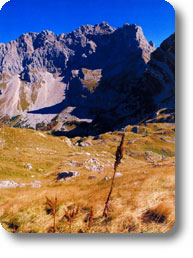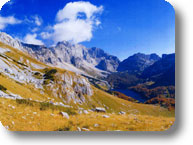|
Points of Interest
|
|
Down the River Tara
|
|
The Tara River is the largest mountain river and the longest one in Montenegro, as well as one of the largest ones in Serbia and Montenegro. It has its headwaters below the Komovi Mountain, from where it flows through the picturesque environment of the Montenegro mountains Bjelasica and Ljubisnja on the right side, and Sinjajevina, Durmitor and Pivske Mountains of the left, down to Scepan Polje and, together with the Piva River it creates the Drina River there.
Down its course, the Tara has created a valley that in the second half of the course transforms itself into a canyon that represents the deepest river erosion in our country and in Europe, while it is the second deepest one in the world, right after the Grand Canyon in the USA.
In 1977, the Tara Basin was included in the UNESCO program "Man and the Biosphere" as an extraordinary ecological reserve, and in 1980 the National Park Durmitor, together with the Tara basin, was included in the list of the world's cultural and natural heritage sites. Following the Tara down the canyon, you will find:
- Crna Poda, the pristine forest of the black pine tree
- St. George's Monastery in Dobrilovina
- Salintraca Cave
- Corbudzak, the spring originating directly below the highway Mojkovac-Zabljak, where travellers often stop to rest
- Vaskovska River, running into the Tara River at the 12th km of the Canyon, at the altitude of 655m
- The Monastery of Assumption of Our Lady (Dovolja) in Premcani village
- Cavcanica den, 128 m long, 92 m deep
- The raft-stop or Sljivansko, a place from which the vessels depart to go rafting down the Tara
- Ljutica River, the biggest tributary of the Tara
- The Big Bridge on the Tara
- Monastery of St. Archangel Michael in Durdevica Tara
- The Roman Bridge in Lever Tara or the Leverski Bridge (Lever in Turkish means the guard or the soldier)
- Bijela vrea, a very strong and rich source
- Lazin Kamen, the place where big deposits of wood were created during the period in which timber was transported down the Tara river
- Draga River, the right tributary originating on the southern slopes of the Ljubisnja mountain
- Radovan Luka, a plateau on the left side of the Tara River. It houses the motel of the National Park Durmitor, with 51 beds and the campsite.
- The bridge in Tepca, hanging cable bridge
- Sige Bajlovica waterfall
- The Susica River, the left tributary of the Tara
- Nozdruc, the spring and waterfall on the left side
- Sige Jovovica waterfall
- Cable Bridge - Bijeli brijeg, no longer used
- Brstanovica camp, with cottages and tent accommodation
- Remnants of the bridge and the dam Uzlup
- ...and many others!!!
|
|
Forest Reserves
|
|




|
The forests and forest ecosystems represent the most important natural potential on the locality of National Park Durmitor by its existence and importance.
The woods and the woodlands occupy an area of about 20,000 ha out of which the woods of the Tara and Susica canyons occupy 9,637 ha.
The high forests of National Park Durmitor occupy only 8%, the sprouts’ forests 2% and brush woods 13% of the total area of the Park.
The woods of Durmitor NP, according to its protection, are divided into:
- the woods under strict protection regime
- protected woods
- park woods
- the woods with mixed purpose.
|
|
In the zone of the forests which are under strict protection regime, there are 5 distinguished localities:
- Crna Poda
the natural reserve characterized by the trees of black pines (Pinus nigra Arnold.), about 400 years old, up to 51,1m high, with the diameters up to 120cm and with volume of over 1600m3/ha
Described communities in the reserve are:
- Pineto-Fagetum oxalidatosum prov.
- Pineto-Fagetum saliculacetosum
- Pineto-Fagetum seslerietosum prov.
- Basin of Mill's Brook
the primeval reserve of pine and juniper woods with the extract of beech above 1,600 m a.s.l. The surface of the reserve is 10 ha.
- Canyon of the River Susica
the mixture of beech and pine woods. Above Susica Lake, the quality composition of beech wood (Fagus silvatica) and maple wood (Acer pseudoplatanus) are present.
- Vaskovo Rocks
are stretched by the edges of the canyon of the river Tara, where were the rare species of Mountainous beech wood (Pinus hldreichii) found.
- Dragisnica
the natural reserve where mixed deciduous – conifer woods are presented.
|
|
Cultural and Historical Heritage
|
|
The numerous monuments of the Durmitor National Park could be divided into several groups:
- tumuli
- necropolises
- the Greek and Roman graveyards / tombstones ”stecci“
- fortifications and monastery complexes
- the churches from the 19th century
- national construction
|
|
|


|
Necropolises
The necropolises in Novakovici and Bare Zugica known as ”the Greek and Roman graveyards”, abound in the great number of “stecci”, which resist the time as the permanent guards and the witnesses of the historical events.
Monasteries
Among the mediaeval monuments, the monastery complexes in the valley of the river Tara are worth mentioning: the Monastery of Dovolja (15th century); the Monastery of St Archangel Michael on the river Tara (15th century); the Monastery of Dobrilovina (16th/17th century).
A hundred meters above Djurdjevica Tara, on the flat ground Vruljci, the monastery of St Archangel Michael has been rebuilt, on the foundation of the church from the 15th century.
The monastery of Dobrilovina dedicated to St George is situated in the vivid area of the village Gornja (Upper) Dobrilovina on the tame flat above the river Tara. It is built in 1609 and it has the wooden belfry in front of the entrance. In the courses of the 17th and 19th centuries the monastery was the important cultural centre.
Churches
The important cultural historical monuments are the churches made on the foundations with the belfry on “distaff”, built from the middle of the XIX century:
- the church of Svetog Preobrazenja (Holy Transfiguration Church) in Zabljak
- the church of St George in Medjuzvalje
- the church of Svetog Preobrazenja (Holy Transfiguration Church) in Krs
- the church of St Nikola in Tepci
- the church of St Spasa (St Salvation) in Mala Crna Gora
- the church of St George in Novakovici.
Cultural Monuments and Rural Architecture
The bridge on Djurdjevica Tara, by its monumentality and historical events related to it, represents the unique cultural monument. Being built between 1937/40, the grand bridge is 365m long, 172m high with five magnificent arches, the biggest one stretches 116 m.
The construction of the rural architecture is also worth mentioning: the summer houses in “katuni”, so called “savardaci” – round cottages with steep roofs thatched by the straw, and watermills around Durmitor’s brooks.
Further information
|


